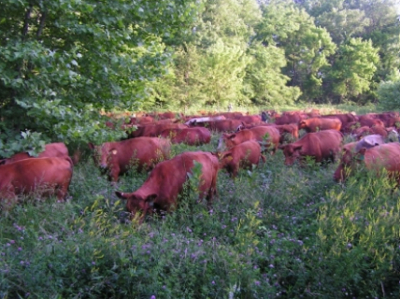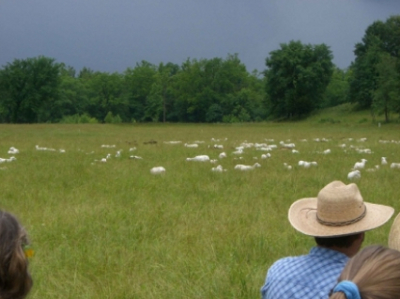
Trampling grass to renovate poor pastures
 The reason I'm so interested
in mob grazing (even though we're unlikely to have large livestock any
time soon) is the potential for renovating poor soil. Next week,
I'll cover a few other ways that mob grazing can improve pastures, but
today I want to focus on trampling.
The reason I'm so interested
in mob grazing (even though we're unlikely to have large livestock any
time soon) is the potential for renovating poor soil. Next week,
I'll cover a few other ways that mob grazing can improve pastures, but
today I want to focus on trampling.
Remember how I mentioned
that Greg
Judy plans for about a third of the grass to be trampled into the soil
during each grazing session? If you're renovating
poor soil, you may need to trample a lot more.
Greg notes that degraded
pastures will generally produce very seedy, poor quality grass the
first year they are managed by mob grazing. He recommends using a
very low stocking density so that your livestock can subsist on the bit
of high quality grass present, then make sure they trample the
rest. Next year, the grass will be more palatable.
The same theory applies
if your pasture has grown up in poor quality weeds. Greg regaled
us with the tale of how he tried to manage a field of cockleburs by
grazing hard every spring in hopes of eradicating the problem.
The result? The cockleburs did better and better each year.
However, once he started ignoring the weeds and managing for grass,
cockleburs were trampled down into the litter and eventually wiped out.
 You might be tempted to let some paddocks
lie fallow if they're very problematic, but Greg recommends against
this. Remember, your livestock are the ones improving the soil,
both with their manure and by trampling down weeds and grass to enrich
the ground. If you have to, give your livestock supplementary
feed that they can eat on pasture, but keep them on the problematic
ground if you want it to improve. (And, whatever you do, don't
mine out the few nutrients you have by haying!)
You might be tempted to let some paddocks
lie fallow if they're very problematic, but Greg recommends against
this. Remember, your livestock are the ones improving the soil,
both with their manure and by trampling down weeds and grass to enrich
the ground. If you have to, give your livestock supplementary
feed that they can eat on pasture, but keep them on the problematic
ground if you want it to improve. (And, whatever you do, don't
mine out the few nutrients you have by haying!)
Finally, plan your
paddock's shape based on the quality of your pasture. Livestock
trample more in rectangular paddocks since they have to mill around to
find the food, so make your paddocks long and skinny while you're in
the soil improvement phase. Once you've build up organic matter
and your pastures are thriving, you can switch over to square paddocks
so your livestock can utilize as much grass as possible.
 This post is part of our Mob Grazing lunchtime series.
Read all of the entries: This post is part of our Mob Grazing lunchtime series.
Read all of the entries:
|
Want more in-depth information? Browse through our books.
Or explore more posts by date or by subject.
About us: Anna Hess and Mark Hamilton spent over a decade living self-sufficiently in the mountains of Virginia before moving north to start over from scratch in the foothills of Ohio. They've experimented with permaculture, no-till gardening, trailersteading, home-based microbusinesses and much more, writing about their adventures in both blogs and books.
Want to be notified when new comments are posted on this page? Click on the RSS button after you add a comment to subscribe to the comment feed, or simply check the box beside "email replies to me" while writing your comment.

Doc --- There's more to come next week, so stay tuned!
Congratulations on buying your own pasture!
Thanks for noticing us on Mother Earth News. I'm still working out the kinks over there, so you probably noticed the post had some formatting issues. I was waiting to tell people until I got them all ironed out, but am thrilled you noticed!